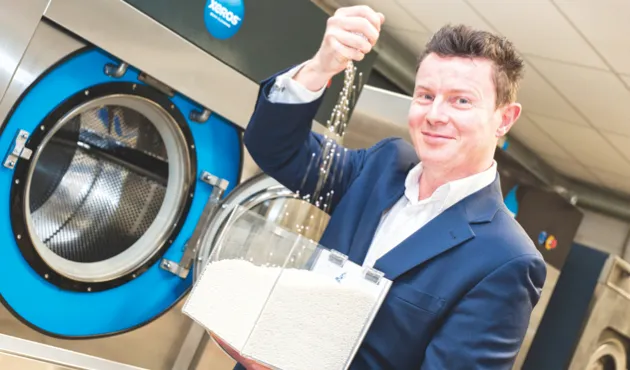Washing your clothes hasn’t changed a great deal in the past 50 years or so. Now, Sheffield-based company Xeros could revolutionise the way you do your washing, replacing the water in your machine with specially engineered beads.
Xeros CEO Bill Westwater explains. “The idea came from the textile design department at the University of Leeds. Leeds, like a lot of northern universities, used to work with textiles in a big way. The researchers, led by chemist Professor Stephen Burkinshaw, were figuring out how to get dyes into materials. And he thought, ‘If I know how to do that, then I can reverse the process. I’ll be able to get food stains out instead.'"
Burkinshaw’s insight led to the development of the world’s first bead-based washing machine, in which millions of reusable nylon beads are used to tackle dirt and stains. Although the beads don’t replace detergent and water completely, the system uses a whopping 80 per cent less water than the most economical conventional washers. Or as Westwater puts it: “We have proven that beads are a superior cleaning medium to water.”
It’s important first of all to understand how a conventional washing machine works. “With a front-loading drum, you have a puddle of water in the bottom, and paddles on the inside of the drum which ‘slap’ the clothes through the puddle as they rotate,” says Westwater. “That’s a crucial part of the cleaning process: it’s always been about contact, right back to when people would scrub clothes by the riverbank. What we do is spray beads into the drum, showering the clothes with beads. This gives better physical contact at all times.”
Once the beads have made physical contact, their electrostatic charge draws the dirt particles in. The third angle of attack in the beads’ favour is the fact that the nylon polymer becomes highly absorbent at 100 per cent humidity. When the nylon passes something called the glass transition temperature, its molecular structure becomes more amorphous and develops spaces in the beads where dirt can accumulate.

A typical 25kg industrial load of washing requires 50kg of beads – approximately 1.5 million of the 3-5mm pellets. The total active surface area is huge, particularly as care has been taken to extrude the beads to a particular shape, size and density.
There are a number of knock-on benefits from the bead system. Because it lets you wash at a lower temperature, fabrics and colours that would normally have to be separated can be washed together, and fabrics take longer to lose their bright colour. “A lot of our early customers are people who wash rented workwear. If that takes longer to wear out, people are saving money further down the line,” Westwater adds.
So when is this housework-slashing device coming to our homes? “We have an advanced-stage prototype in our labs for the domestic market,” says Westwater. “We’ve been able to maintain the savings in a smaller drum, but the truth is we will be targeting American homes first because, as with everything else, they use bigger machines.”
Chris Hall is Science and Technology Editor at Yahoo
Follow Science Focus onTwitter,Facebook, Instagramand Flipboard